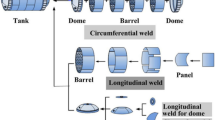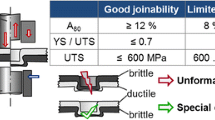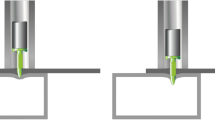Abstract
The implementation of lightweight materials such as modern wrought aluminium and casting alloys enables a significant reduction of the vehicle’s total mass. The extended use of lightweight aluminium castings and extrusions offers considerable potential for weight reduction. The cost-effective joining of these aluminium structures is challenging the conventional thermal and mechanical joining techniques. The paper details the development of a new type of mechanical functional element based on the principle of high-speed joining. Functional elements also know as fuctional attachments are normally attached separately from the fixings which used to join two or more sheets of material. Examples for fuctional elements are brackets, clips and fixing studs. The objective on this paper based project is the further development of the high-productive joining method high-speed joining to integrate a functional element into the joining process. For this, a modification of a given joining element geometry has to be developed that allows the transmission of high-torque moments and reaches high-push-out forces. Therefore, several geometries were developed and optimised with simulations and experimental investigations. The results show that the joining element based on the technology of high-speed joining can meet the requirements of metric aluminium stud-threads with diameters up to 6 mm and steel stud-threads with diameters up to 5 mm.












Similar content being viewed by others
References
Meschut, G.; Janzen, V.; Olfermann, T. (2014) Innovative and highly productive joining technologies for multi-material lightweight car body structures. J Mater Eng Perform 05/2014, S. 1515–1523
Mori K, Bay N, Fratini L, Fabrizio Micari A (2013) Erman Tekkaya, Joining by plastic deformation. CIRP Ann 62(2):673–694, ISSN 0007-8506. https://doi.org/10.1016/j.cirp.2013.05.004
Westhoff D (2015) Entwicklung und Qualifizierung eines Funktionselementes für das einseitige, vorlochfreie Fügen im Karosserierohbau; Dissertation, Universität Paderborn
Grandt, J.: Blindnietgewindesysteme: Typen, Verarbeitung, Einsatzbereiche. Die Bibliothek der Technik Bd. 159; Verlag Moderne Industrie, Landsberg/Lech, 1998
Larson J (2008) Projection welding for nut and bolt attachment—competeting or complementary joining methods?; The fabricatur, Febuary 2008, p 55–57
Larsson JK, Bengtsson L (2007) “The overlooked joining technology of fasteners for modern car body structures—latest experience from nut and bolt attachment to advanced high strength steels,” in proceedings from 11th European automotive Engineers' Council (EAEC), Budapest, May–June
Miller WS, Zhuang L, Bottema J, Wittebrood AJ, De Smet P, Haszler A, Vieregge A (2000) Recent development in aluminium alloys for the automotive industry. Mater Sci Eng: A 280(1):37–49
Szlosarek R, Karall T, Enzinger N, Hahne C, Meyer N (2013) Mechanical testing of flow drill screw joints between fibre-reinforced plastics and metals. Mater Test 55(10):737–742. https://doi.org/10.3139/120.110495
Draht T (2006) Entwicklung des Bolzensetzens für Blech-Profil-Verbindungen im Fahrzeugbau. Dissertation, Universität Paderborn, Shaker Verlag, Aachen
Flüggen F (2014) Qualifizierung des Bolzensetzens als Verfahren zum Fügen höchstfester Stahlwerkstoffe; Dissertation, Universität Paderborn
Möhring J (2011) Qualifizierung von Fügeelementbeschichtungen für den Einsatz des druckluftbetriebenen Bolzensetzens im Karosseriebau, Dissertation, Universität Paderborn
DIN 8580 (2003) Fertigungsverfahren - Begriffe, Einteilung, Beuth Verlag, Berlin
DIN 8593–5 (2003) Fertigungsverfahren Fügen - Teil 5: Fügen durch Umformen; Einordnung, Unterteilung, Begriffe; Beuth Verlag, Berlin
Hahn O, Klemens U (1996) Fügen durch Umformen, Nieten und Durchsetzfügen – Innovative Verbindungsverfahren für die Praxis. Dokumentation 707 der Studiengesellschaft Stahlanwendung e.V.; Düsseldorf
Heimlich F (2008) Beitrag zum Einsatz von Aluminium-Funktionselementen in Leichtbauwerkstoffen; D466 Dissertation Universität Paderborn; Shaker Verlag Aachen
N.N.: Merkblatt DVS®/EFB 3440–1 (2006) Funktionselemente Überblick. Merkblatt des DVS/EFB-Gemeinschaftsausschusses „Mechanisches Fügen“, DVS-Verlag, Düsseldorf
Bye C (2006) Erweiterung des Einsatzfeldes von loch- und gewindeformenden Dünnblechschrauben zum Verbinden von Aluminiumhalbzeugen; Dissertation, Universität Paderborn
Somasundaram S (2009) Experimentelle und numerische Untersuchungen des Tragverhaltens von Fließformschraubver-bindungen für crashbelastete Fahrzeugstrukturen; Dissertation, Universität Paderborn
Kohl D (2014) Entwicklung und Qualifizierung eines Qualitätsprüfkonzeptes für das Hochgeschwindigkeits-Fügeverfahren Bolzensetzen im Automobil-Leichtbau, Dissertation, Universität Paderborn
Hahn O, Meschut G, Nagel P, Flüggen F (2013) Eignung von loch- und gewindeformenden Schrauben zum Fügen von Mehrblechverbindungen. Öffentlicher Abschlussbericht zum gleichnamigen Forschungsvorhaben (EFB-Nr.: 07/209; IGFNr.: 16.694 N), Europäische Forschungsgesellschaft für Blechverarbeitung e.V., Hannover
DIN EN 515 (1993) Aluminium und Aluminiumlegierungen – Halbzeug – Bezeichnung der Werkstoffzustände; Deutsche Fassung EN 515:1993; Beuth Verlag, Berlin
DIN EN 573–3 (2013) Aluminium und Aluminiumlegierungen – Chemische Zusammensetzung und Form von Halbzeug – Teil 3: Chemische Zusammensetzung und Erzeugnisformen; Deutsche Fassung EN 573–3:2013; Beuth Verlag, Berlin
Bender H, Schmale H-C (2015) Launch and quality optimization of bonding processes for mixed material designs in high volume production; Joining in Car Body Engineering, Bad Nauheim, 24.-25 März 2015
N.N.: Merkblatt DVS®/EFB 3480–1 (2006) Prüfung von Verbindungseigenschaften – Prüfung der Eigenschaften mechanisch und kombiniert mittels Kleben gefertigter Verbindungen. Merkblatt des DVS/EFB Gemeinschaftsausschusses, DVS-Verlag, Düsseldorf
Voce E (1955) A practical strain-hardening function. Meta 51:219–226
Hockett JE, Sherby OD (1975) Large strain deformation of polycrystalline metals at low homologous temperatures. J Mech Phys Solids 23(2):87–98, ISSN 0022-5096. https://doi.org/10.1016/0022-5096(75)90018-6
Cockroft MG, Latham DJ (1968) Ductility and workability of metals. J Inst Met 96:33
Lee HC, Choi JS, Jung KH, Im YT (2009) Application of element deletion method for numerical analyses of cracking. J Achiev Mater Manuf Eng 2:154–161
Acknowledgments
In this paper, selected results of the funded research projects IGF No.: 17807 N (EFB No.: 06-209) were presented. The IGF project IGF No.: 17807 N (EFB No.: 06-209) of the Europäischen Forschungsgesellschaft für Blechverarbeitung e. V. was promoted through the AiF under the program for the promotion of joint industrial research and development (IGF) by the Federal Ministry of Economics and Energy due to a resolution of the German Bundestag.
Author information
Authors and Affiliations
Corresponding author
Additional information
Recommended for publication by Select Committee AUTO - Automotive and Road Transport
Rights and permissions
About this article
Cite this article
Nagel, P., Meschut, G. Combining a high-speed mechanical joining technique with the attachment of functional elements in automotive structures. Weld World 62, 215–225 (2018). https://doi.org/10.1007/s40194-017-0528-8
Received:
Accepted:
Published:
Issue Date:
DOI: https://doi.org/10.1007/s40194-017-0528-8




